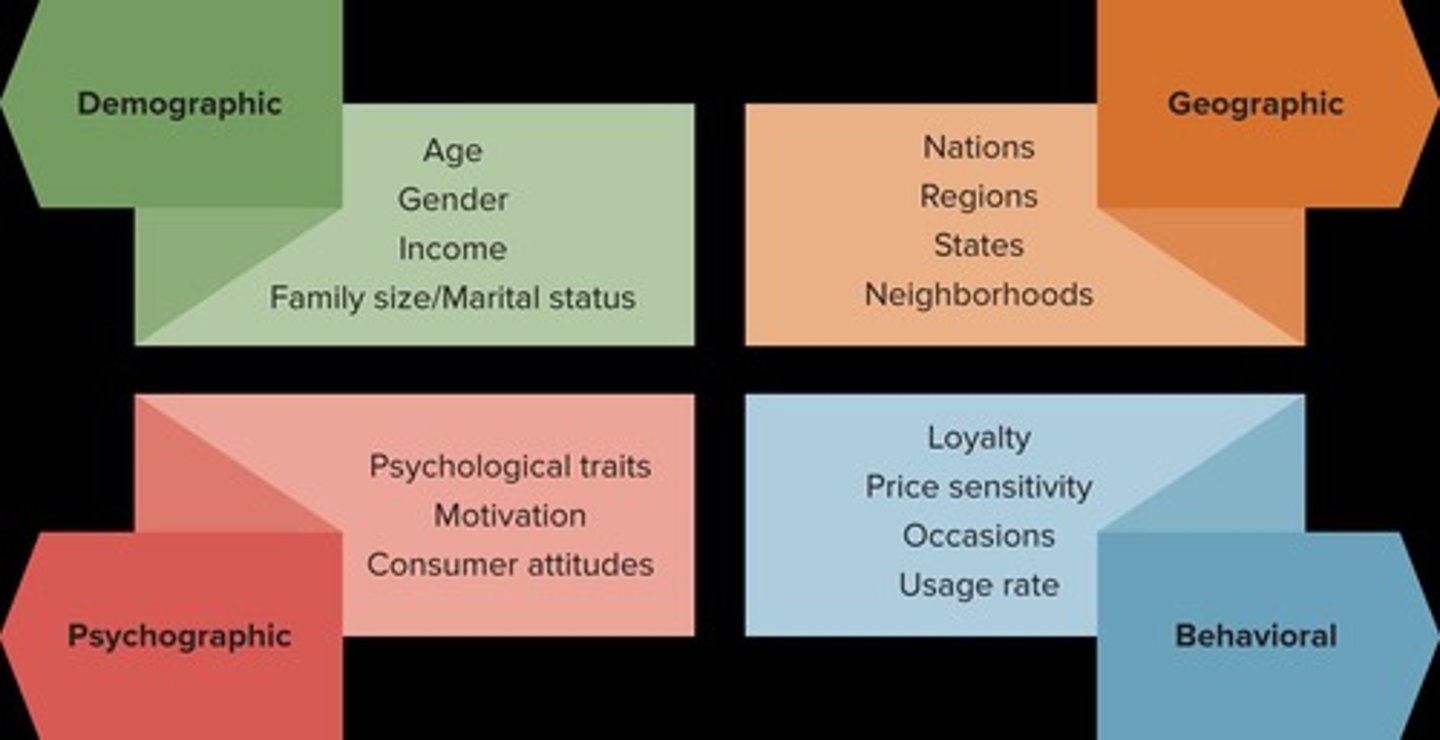Marketing Chapter 7: Market Segmentation, Targeting, and Positioning in Marketing
1/35
There's no tags or description
Looks like no tags are added yet.
Name | Mastery | Learn | Test | Matching | Spaced |
|---|
No study sessions yet.
36 Terms
Market Segmentation
Understanding market segments helps firms define needs and wants of customers, design specific marketing strategies, and decide how to allocate marketing resources.
Criteria for Effective Market Segmentation
Substantial, Measurable, Differentiable, Accessible, Actionable.
Substantial
Large enough for firm to make a profit.
Measurable
Size and purchasing power clearly identified.
Differentiable
Must be able to be differentiated.
Accessible
Must be able to reach and serve the segment.
Actionable
Must be able to develop strategies that attract certain segments.
Demographic Segmentation
Segments based on Age, Gender, Income, Marital status and family size.

Geographic Segmentation
Segments based on Market size, Customer convenience, and Population shift due to economic conditions, retirement, natural disasters.
Psychographic Segmentation
Lifestyle segmentation divides people based on opinions, interests, and activities.
VALS Network
Identifies three motivations: Ideals, Achievement, Self-expression.
Behavioral Segmentation
Variables include occasions, loyalty, and usage rate.
80/20 Rule
20 percent of heavy users account for 80 percent of the total demand for a product.
Business-to-Business Segmentation Bases
Includes Demographic, Geographic, and Behavioral segmentation.
Global segmentation
Segmentation based on global markets.
Regional segmentation
Segmentation based on specific regions.
Unique segmentation
Segmentation based on unique characteristics of a market.
Target Markets
Specific groups of consumers a business aims to reach.
Targeting
The process of identifying and reaching target markets.
Undifferentiated targeting
A strategy that targets the entire market with one offer.
Differentiated targeting
A strategy that targets multiple segments with different offers.
Niche marketing
A strategy focused on a specific, well-defined segment.
Growth potential
The expected increase in market size or demand.
Level of competition
The intensity of rivalry among businesses in the market.
Strategic fit
Alignment of target market with the company's goals and resources.
Perceptual map
A visual representation of consumer perceptions of brands.
Positioning
The process of establishing a brand's identity in the market.
Positioning Statement
A statement that summarizes the brand's competitive advantage.
Repositioning
Changing the market position of a product or brand.
Evaluating feedback
The process of assessing responses from the target market.
Ethical concerns
Moral considerations in marketing practices.
Children and older adults
Demographic groups that require special marketing considerations.
Rise of 'tween' consumers
The increasing influence of pre-teen consumers in the market.
Reverse mortgages
A financial product that raises ethical concerns in marketing.
Disney's 'Mickey Check'
A seal of approval indicating healthy food options for children.
Elmer's glue repositioning
Rebranding traditional products as ingredients for making slime.
